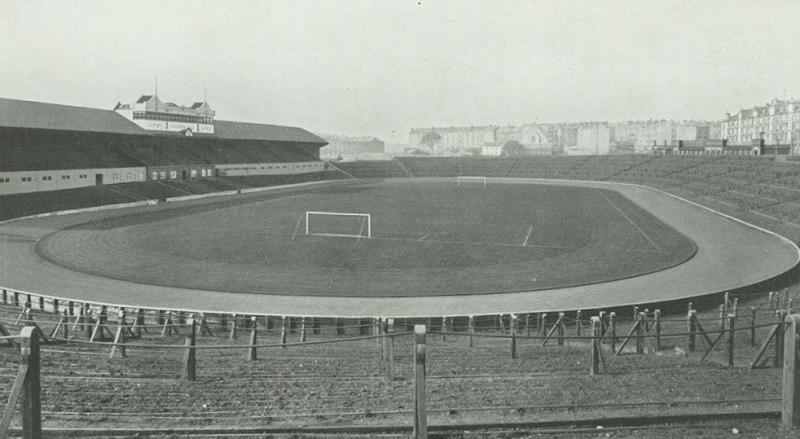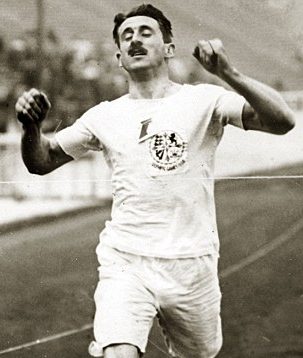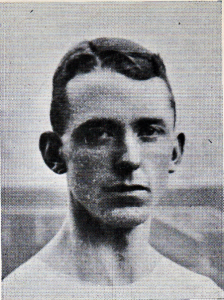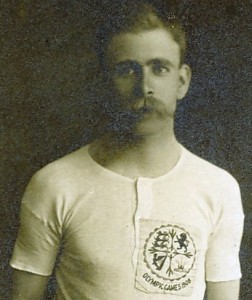The Queen’s Park Football Club Sports had been one of the best meetings in Scottish athletics as well as one of the first, they would also be one of the best athletic spectacles of the 20’s and 30’s, but there was a wee hiatus at the start of the twentieth century, for reasons to do with professionalism and corruption which are worthy of a separate page in their own right before the sports made their comeback in 1907. On this page we take a look at the sports after they started up again using only the Glasgow Herald coverage. Amateur athletics had been formally organised since 1883 with the founding of the SAAA and the first open athletics clubs appeared in 1885. There was continual friction between the two codes – amateurism and professionalism. There was no doubt about the corruption in professional athletics – and at times there was an overlap with prominent amateur athletes colluding with the pedestrians or even just emulating some of the worst practices.
The Glasgow Herald preview of the QPFC games in 1907 observed “Great changes have taken place in the Cathcart District since Queen’s Park last held sports. The residential population must be triple what it was in 1900, and with the amateur sentiment pre-eminent there is no reason why the Queen’s gathering on Saturday should not be as well patronised as any ordinary football match. It is no secret that there was a section of the mangement against holding sports, but on the other hand another section, perhaps the more progressive elements in committee, pointed out that the club, apart from fostering school football, did comparatively litle in promoting amateur sport, and in the long run it was agreed to revive what at one time was the most interesting function in the Scottish athletic season. The Queen’s are hopeful of having among their entrants several distinguished athletes, and JW Morton who is having a short holiday in Scotland, may take part in the two sprints.”
The sports took place on June 15th, 1907, and the report on them read as follows:
“QP SPORTS
If the revival of the Queen’s Park FC Sports failed to produce a renewal of public interest in amateur athletics the faultisnot theirs, for nothing finer in the way of competition has been seen at any city meeting this season. As a matter of fact the racing all round was exceptionally interesting, and at the same time was characterised by a keenness which must have recalled to many the earlier athletic festivals of our leading club. Amateur running has been largely cleansed of the excrescences which sullied it in the eyes of so many, and there is in the near future a beneficent career for this cult of athletics. The Hampden track was sodden, yet for all that the “times” in some instances were fast, and with careful handling and a little judicious expenditure there is no reason why the Queen’s ground should not be the home of athletic records.
Local support would be pleased when PR Grant, an old Queen’s Park back, won the 100 yards in 10 3/5th off 8 yards, the handicap mile was won by AB Hepburn with John McGough a yard behind, the schools relay was won by Allan Glen’s, the relay by Bellahouston Harriers. Judges reckoned that on a dry track with a clear run, McGough’s time would have been worth 4:20. The sports had returned and were a sporting success if not a financial one.
The QPFC Sports were held on 20th June 1908 and built upon those of the previous year, The Glasgow Herald report read as follows:
“Hampden is a fast track. This was made abundantly clear at the Queen’s Park Sports on Saturday. And were the same care and expense lavished on it that are lavished with no stinted hand on other parts of this great enclosure, it might be the fastest path in Scotland. Lieutenant Halswell placed an athletic record to the credit of Hampden on Saturday; in other words he invested new Hampden with the glory that circled old Hampden, as it was there that AR Downer rean 300 yards in 31 2/5th sec. Halswell reduced this by a fifth of a second. This looks rather mean in cold type, but its value is best measured by the fact that Downer’s time has held the field since 1895. That Halswell is a commanding personality in the athletic realm is now well known; he has given amateur pedestrianism a romanticism that it has not possessed since Downer was on the scene and it is the firm conviction of those who are versed in these matters that he will ere long gild his name with world’s record over the 300 and 440 yards distances. Last Thursday at Parkhead he won the quarter invitation handicap in the West of Scotland Harriers in 49 4/5th sec, this coupled with his all-comers record on Saturday constitutes great work.”
“Another fine performance was J Fairbairn-Crawford’s half-mile in 1 min 58 1/5th sec which is a second worse than his record in the Irish International at Ibrox two seasons ago. But in that race there was no one to interrupt his progress, whereas at Hampden he had to plough through a field of fifty. The fact is that Crawford would have run the race of his life on Saturdy had he been permitted to move freely. The race was won by Adam Turnbull (Clydesdale Harriers), 29 yards in 1 min 56 3/5th sec which is the finest display of running he has ever given
“Then the mile was the fastest – 4 min 21 4/5th sec – that has been run in Scotland this season. D Rutherford was the winner and , like Turnbull, he exhibited resources that few had credited him with. John McGough was not seen at his best; as a matter of fact it was obvious to all that he was running under physical disabilities. …. There was some very fine sprinting in the 100 yards and 220 yards. RC Duncan, a member of Queen’s Park, won the former from scratch in 10 2/5th sec, and the latter was captured by M Neilson, West of Scotland Harriers, 12 yards, in 22 4/5th secs.
The report was a bit longer and is worth reading, but these were the main results from a well organised meeting which also contained cycle racing and finished by saying
“The Queen’s Park may not have made a princely sum off their meeting on Saturday but they have the satisfaction of knowing that they have given the cause of athletics a much-needed lift in public favour.” The lack of a princely sum was maybe more significant than the report knew.
John McGough
Whatever the success of the 1908 meeting, 1909 turned out to be a disappointment – maybe for good reason. The Glasgow Herald of 7th June 1909 carried the following note: “Desirous that nothing should interfere with the success of the Australians visit to Partick Queen’s Park have abandoned their sports on June 19th. A proposal to this effect was submitted by the sub-committee entrusted with the arrangements and needless to say the General Committee cordially assented. Sports Meetings are everyday fare but cricket such as the Australians provide is a luxury.” In the cricket match on the 19th, the Australians of course won easily but the event was a great success. It is however a sign of the times that a football club would forego its athletic sports in favour of a cricket match.
Tom Jack
In contrast to the verdict in 1908, the report on the meeting of 18th June 1910 began: “Hampden Park will not be complete until the cinder path is in better order than it was on Saturday. Far too little attention has been given to this necessary and vital equipment but now that the Queen’s Park have come to recognise that it is part of their mission to foster amateur athletics it is just possible they will overhaul the track before another season comes round.”
As far as the performances were concerned: “While there was an absence of what one might term sensational performances at Hampden Park on Saturday, there was from the point of view of the student of athletics, what is perhaps more satisfactory, a pretty general excellence , exhibiting alike a highly creditable standard of efficiency and keen competitive emulation. Those features kept the spectators engrossed all the time and viewed therefore from whatever standpoint, the sports of the Queen’s Park Football Club were quite a success.”
The sports themselves had 100, 220, 880 yards races, one mile, two miles team race, schools relay race, obstacle race, highjump and several cycle races. The standard was high despite no records being broken –
eg Tom Jack, seven times Scottish 10 miles champion and cross country internationalist, won the half-mile and Mile,
Alex McPhee, SAAA four miles and cross-country champion in 1909, ran in the two miles,
RT Duncan, SAAA 100y and 220y champion and internationalist was off scratch in the sprints.
And an interesting competitor was Ralph Erskine of Allan Glen’s who was second in the high jump – he would go on to win the SAAA half mile title, become world lightweight boxing champion after winning the itle bout in New York before tragically being kille in action in January 1918.
*
1911 was the year of the Great Exhibition, a mammoth event encompassing all aspects of a civilised society. The Festival of Empire, or Great Exhibition, was held at the Crystal Palace in London from 12th May to celebrate the coronation of King George V. Wikipedia tells us thata pageant, organised by ‘Master of the Pageants’ Frank Lascelles, dramatising the history of London, England and the Empire was held. The first performance of the pageant was on 8 June 1911; in four parts, performed on separate days, it celebrated the ‘magnificence, glory and honour of the Empire and the Mother Country’. Music was provided for The Pageant of London by 20 composers including Ralph Vaughan Williams, Gustav Holst, Frank Bridge, Cecil Forsyth, Henry Balfour Gardiner, Edward German and Haydn Wood. This was performed by a military band of 50 players and a chorus of 500 voices. As part of the festival, an Inter-Empire sports championship was held in which teams from Australasia (a combined team from Australia and New Zealand), Canada, South Africa, and the United Kingdom competed in five athletics events (100 yards, 220 yards, 880 yards, 1 mile and 120 yards hurdles), two swimming events (100 yards and 1 mile), heavyweight boxing and middleweight wrestling. This is regarded as a forerunner of the British Empire Games (now Commonwealth Games), held from 1930.
In the Glasgow Herald of 15th May, 1911, the following appeared in the ‘Sports Miscellany’ column. “Queen’s Park FC have resolved not to hold sports this season. ” The date would be given to Paisley Harriers Juniors who were trying to raise the profile of the sport in their area but a week later, in the Herald of 22nd May, the Sports Miscellany reported that “It is just possible that the Queen’s Park Sports may come off after all. A proposal has been made by the West of Scotland Harriers which has found favour in influential circles, and the matter will be considered one of these days by the committee of the Queen’s Park. There has been considerable comment of an adverse kind at the decision of the Queen’s Park to abandon their meeting because of the opposition of the Exhibition, and it is now being felt that, all things considered, there was no justification, or at all events very little for cancelling the meeting. Should the proposal being made to the Queen’s Park result in the sports taking place, there will be general satisfaction in athletic circles as, after all, the amateur traditions of the old club carry with them a significance of which few, if any, other city functions can boast.”
The Paisley Junior Harriers meeting on the third Saturday in July was successful and the forecasts by the club and the Press were that they would continue to use this date which had hitherto been the property of the Queen’s Park. From reports, it would seem that unfortunately the QP sports did not in fact take place that year.
*
1912 did not look too promising either when the following appeared in the Herald: “The Queen’s Park FC have intimated to the Scottish Amateur Athletic Association that the new committee have decided not to hold sports on June 22nd – a date exclusively reserved for them by the Association. This means that the recommendation, if not the reasoned decision, of the old committeee has been rejected, and it also means a regrettable departure for the time being, if not for all time, from the line of policy in regard to amateur athletics which has won for Queen’s Park the admiration of all broad-minded sportsmen.”
The following week it was announced that on 22nd June, later than usual, Allan Glen’s School would hold their school championships at Hampden. This seemed to put the kybosh on any amateur sports s for 1912 sponsored by the football club at Hampden. By July the stuation had altered slightly and it was announced that the Queen’s Park FC confined sports would be held at Hampden in August. It is an interestingconcept – would it translate to present day football??? However, the Glasgow Herald of 15th July, 1912, had the following
“Queen’s Park FC are making an interesting departure early in August in connection with their own confined sports; they will include either two or three handicaps open to all-comers. It is just possible that the meeting will be sandwiched between the Rangers and Celtic functions, with the hope, no doubt, of getting one or two of the big guns who are coming to Glasgow for these meetings to show their paces. The Queen’s Park, to the great regret of many of their warmest supporters dropped their meeting in June, and it is by way of compensation for that disappointment that they are including a few open races at their club games next month. If the American and other Olympic competitors are in Glasgow during the first ten days of Augustit will be interesting to see if they are allured by the Hampden bait.”
On July 29th – “The Queen’s Park will run two open handicaps – 100 yards and 880 yards – in connection ith their club sports on Thursday first.”
It was at least a gesture, a move that the club did not have to make, but one that was welcomed by the sports loving public. The actual event wasn’t reported in the Herald which is hardly surprising give that it was at a very busy time of the year – ir Rangers Sports on the first Saturday and Monday of August and Celtic Sports on the second Saturday and Monday, as well as several well established meetings (eg Strathallan)
The club’s interest in athletics was still in evidence in 1913 when it was anounced that the Glasgow High School spots were to be held at Hampden. “This is a step in the right direction as Scotstoun is not very well adapted for school games. Besides there are interesting associations springing up between the High School and some of the older officials of the Queens Park club, and the closer the relations the greater the benefit both to the school and to QP.” (Herald, April 28th, 1913)
The sports were previewed on June 2nd, and after looking at some of the events, particularly the relays, it ended with a comment that “Mr Charles Stewart, who does a lot more for athletics in a general sense at the High School than most people are aware of, is again responsible for the arrangements and these, with the help hewill receive from members of Queen’s Park FC, should add to the enjoyment of the proceedings.”
The meeting was held the following Saturday with several, nor many, running events, some field events and several such as the drop kick, sack race (one each for former pupils and ‘open to school’), and 300 yards in football costume (confined to Glasgow High School FP FC).
Very interesting and the note on 28th April about relations with the High School is encouraging – but there is no note in the Herald of any sports meeting – open or confined – organised by Queen’s Park that year.
1914 saw the outbreak of War but a whole season was carried through before hostilities commenced. It was however another season without a Queen’s Park FC Sports meeting. They were involved in amateur sport throughout the season – The Queen’s Park School Sports were held at Hampden free of charge on 6th June, Allan Glen’s School sports were held on 20th June and then on 29th June it was reported that as hosts to the upcoming International between Scotland, England and Ireland, – QP are lavishing a deal of care on their cinder path at Hampden in view of the triangular athletics match there on July 11th. It already has one record – Halswell’s 300 yards- and there is no reason why it should not have more.”
With war looming, the August 224th Glasgow Herald announced that Queen’s Park had donated £250 to the Glasgow War Fund with a promise that more would be contributed if required. There had been no promoted meeting, but there had been a continuing presence of Queen’s Park in amateur athletics from schools sports to international fixtures.
*
We know that there were sports held by the club throughout the 1920’s but the on-again/off-again nature of the event in the period from 1900 to 1914 was strange in view of the other events reported at the time. The Queen’s Park was famous for its staunch adherence to the amateur code – a fact remarked upon in 1907 and 1908 when they were started up again. But the situation in Glasgow was not quite as clear cut as the SAAA might have us believe. For instance, the Glasgow Police Sports were accused of “Profesionalising Schoolboys” by having schools relays and sprint in their meeting on July 11th, Clyde FC were said to be “whole hoggers” when it came to professional athletics, indeed pre– and post-amateur athletics, there were weekly professional meetings at Shawfield with big crowds, biggish money prizes and quality professional athletes competing and there was a prominent note on “pedestrian development at Shawfield.” Even Celtic FC put on some mid-week professional athletic meetings. In such an atmosphere it might have been thought that Queen’s Park FC would have made a point of flying the amateur flag. There were hints of disagreements within the club committee on the merits of holding athletic sports and at the time of the start o the war, there had been none for two years.
The thread will be picked up in another post.



